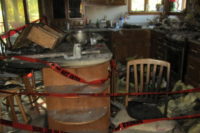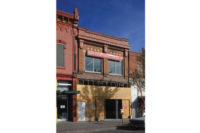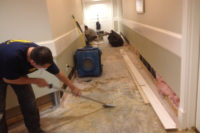Case Study: Drying a 35,000 Square-Foot Store
On April 14, a tornado came down on Creston, IA so quickly that it even caught emergency management officials off-guard - it materialized so fast that none of the city’s tornado sirens were activated.

On April 14, a tornado came down on Creston, IA so quickly that it even caught emergency management officials off-guard - it materialized so fast that none of the city’s tornado sirens were activated.
Reports say that heavy rain hid the twister, which touched down only about five minutes before striking Creston and, according to the National Weather Service, was moving over 40 mph. The twister struck around 7 p.m. and clipped the northern edge of town, damaging a nearby hospital, community college and a number of homes and businesses.
Pat Riley, owner of Rainbow International of Winterset, IA, was called in to measure the damage in the town and do immediate water mitigation on a 35,000 square-foot True Value hardware store.
“There were numerous jobs to be done and I realized that working as a team would be the best way to begin restoring all the damage,” said Riley. “Our Rainbow International locations from Perry, Beaman and Davenport all participated with equipment and personnel.”
Bill Yount, an insurance agent with Hometown Insurance in Greenfield, IA, was witness to the recovery process from start to finish.
“During the storm the heating and air conditioning units were ripped right out of the roof and then bounced around,” he says. “There were big holes everywhere and the weather wouldn’t let up. It continued to rain off and on, and the roof was leaking really badly.”

Insulation was suspended about a foot below the entire ceiling and was entirely saturated with the invasion from the continuing storms. Below the ceiling was a multi-million dollar inventory just waiting to be destroyed.
After assessing the situation, the Rainbow International crews decided against ripping the ceiling down and began drying out the insulation with heaters, fans and blowers.
“We originally thought that all of the inventory and most of the insulation would have to be removed and that it would take at least two, maybe three months, to get the store back open,” Riley said. “However, we were able to dry the insulation, move a minimal amount of merchandise, and get them up and running again in 30 days.”
The crews used thermal imaging cameras to locate the heavier pockets of water and proceeded to extract as much moisture as possible via truckmount extraction units. They used two 1.2 Million BTU Rx Heat Units strategically ducted into the ceiling cavity in order to dry the area.
Throughout the rest of the structure, they used standard drying practices with air movers and dehumidification, and continually used thermal imaging to identify the pockets of moisture in the ceiling. This process significantly sped up the drying process.
In addition, the team worked together on many other commercial and residential projects in the tornado’s aftermath. While restoring the 35,000 square-foot hardware store, they also worked on five additional commercial properties and 16 residential properties.
Looking for a reprint of this article?
From high-res PDFs to custom plaques, order your copy today!





